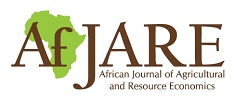Opportunity cost of adopting improved planted forage: Evidence from the adoption of Brachiaria grass among smallholder dairy farmers in Kenya
Kevin W. Maina, Cecilia N. Ritho, Ben A. Lukuyu, & Elizaphan James O. Rao
Abstract
Current global trends in population growth, urbanisation and a growing middle-class economy have resulted in increased demand for livestock and products, and more so dairy products. This necessitates the need for livestock producers to respond to the growing demand. However, farmers’ efforts are aggravated by the effects of climate change. The need arises for a sustainable source of fodder to alleviate the situation, while at the same time offering farmers other opportunities to participate in fodder markets through the adoption of climate-smart Brachiaria grass. In this article, the opportunity cost of producing Brachiaria in favour of Napier grass is estimated using household survey data obtained from dairy farmers in Kenya’s drier agro-ecological zones. The study utilised full-information endogenous switching regression to compute the opportunity cost by comparing the
gross margins generated from Napier and Brachiaria grass. The findings reveal that dairy farmers face a higher opportunity cost of their fodder land by producing Napier in favour of Brachiaria, given by the transitional heterogeneity of USD 79.74. Furthermore, the adoption of Brachiaria is determined by the age and experience of farmers in fodder production, by herd size, breed type, perception of milk productivity, group membership, and access to extension services. The results highlight the need for widespread adoption through extension and technical support to farmers. This would also enable farmers to participate in fodder markets and support their livelihood.
